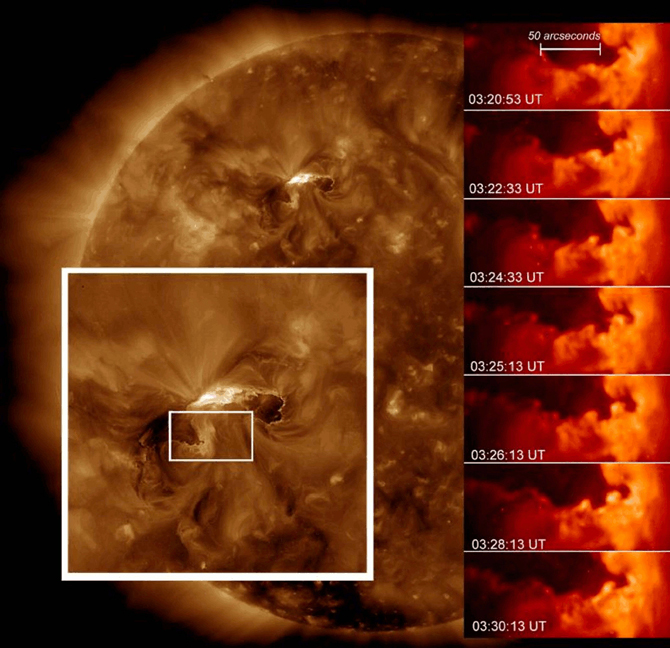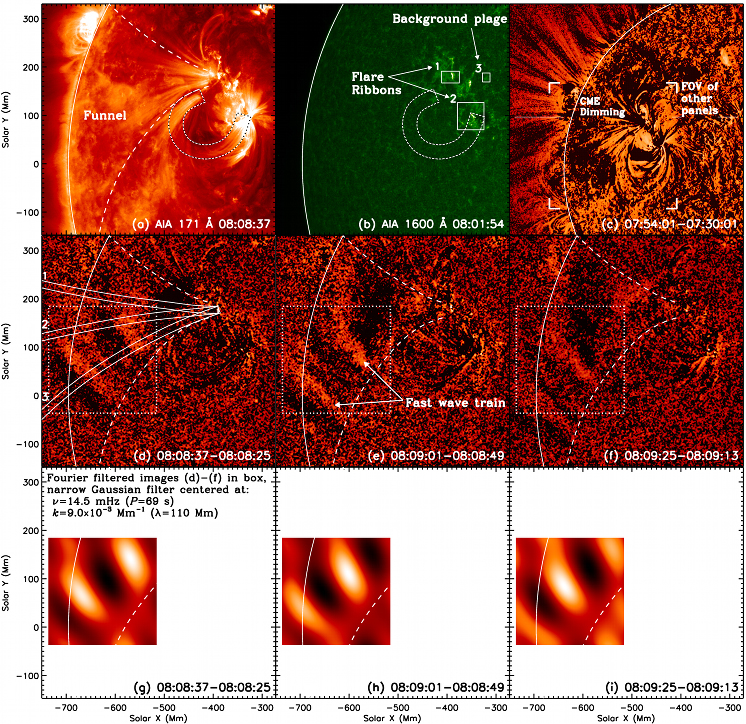Sun Has Giant Supersonic Waves Bigger Than Earth

Humongous waves of hot plasma roiling on the surface of the sun appear to be moving at speeds as high as 4.5 million miles per hour, a new study found. The waves are so huge it would take up to 16 Earths, end-to-end, to match them.
It's the first unambiguous evidence that the sun's lower atmosphere contains such superfast "magnetosonic waves," scientists said.
The fast waves have velocities of 2.3 million to 4.5 million mph (1,000 to 2,000 kilometers per second), periods in the range of 30 to 200 seconds, and wavelengths of 62,000 to 124,000 miles (100,000 to 200,000 kilometers), equivalent to stacking between eight to 16 Earths on top of one another. [Amazing New Sun Photos from Space]
Scientists discovered the waves with the Atmospheric Imaging Assembly instrument on NASA's Solar Dynamics Observatory (SDO), dedicated to observing the sun from orbit around Earth.
Ripples in a pond
Waves on the sun are produced when a flare or eruption on the solar surface kicks up hot plasma, similar to ripples in water produced when a rock is dropped into a still pond.
Scientists have observed slow-moving waves on the sun, but fast-moving waves, which were also predicted by theory, had so far gone undetected because previous space telescopes could not take pictures rapidly enough to image these fast waves. [Video: Enormous Surfer Waves on Sun Hotter Than Hell]
Get the Space.com Newsletter
Breaking space news, the latest updates on rocket launches, skywatching events and more!

"They seem to be a common phenomenon," said Karel Schrijver, principal physicist at the Lockheed Martin Solar and Astrophysics Laboratory in Palo Alto, Calif., in a statement."During the first year of the SDO mission, despite the sun being relatively quiet, we have seen about a dozen such waves. Although their exact trigger mechanism is currently under investigation, they appear to be intimately related to flares that sometimes exhibit pulsations at similar frequencies."
Enigmatic processes
Waves such as these are believed to be responsible for many fundamental, yet enigmatic processes on the sun, such as heating the corona to millions of degrees, accelerating the solar wind, triggering remote eruptions, and delivering energy and information between different parts of the atmosphere.
By observing these waves, scientists hope to better understand the solar physics of such processes and their consequences on near-Earth space and the terrestrial environment.
"This discovery and analysis is very significant because we are witnessing phenomena of which we were previously unaware," said Alan Title, principal investigator of the Atmospheric Imaging Assembly at the Lockheed Martin lab, who first noticed the fast propagating waves in routine SDO movies."In light of this discovery, the more we look at solar flares, the more of these waves we see, and as observation and analysis lead to insight, the better we will understand the processes involved."
Stanford University scientist Wei Liu, a research associate at the Lockheed Martin laboratory, presented the findings today (June 15) at the annual meeting of the Solar Physics Division of the American Astronomical Society in Las Cruces, N.M. The researchers also detail their discovery in a paper to be published in The Astrophysical Journal Letters.
Surfer waves on the sun?
Another recent study of waves on the sun found "surfer" waves the size of the United States in the solar corona.
These so-called Kelvin-Helmholtz waves, also discovered using data from SDO, could help astronomers understand how energy moves through the solar atmosphere.
"One of the biggest questions about the solar corona is the heating mechanism," said solar physicist Leon Ofman of NASA’s Goddard Space Flight Center in Greenbelt, Md., and Catholic University, Washington. "The corona is a thousand times hotter than the sun's visible surface, but what heats it up is not well-understood. People have suggested that waves like this might cause turbulence which cause heating, but now we have direct evidence of Kelvin-Helmholtz waves."
That research was published online on May 19 in the Astrophysical Journal Letters.
Follow SPACE.com for the latest in space science and exploration news on Twitter @Spacedotcom and on Facebook.
Join our Space Forums to keep talking space on the latest missions, night sky and more! And if you have a news tip, correction or comment, let us know at: community@space.com.

Space.com is the premier source of space exploration, innovation and astronomy news, chronicling (and celebrating) humanity's ongoing expansion across the final frontier. Originally founded in 1999, Space.com is, and always has been, the passion of writers and editors who are space fans and also trained journalists. Our current news team consists of Editor-in-Chief Tariq Malik; Editor Hanneke Weitering, Senior Space Writer Mike Wall; Senior Writer Meghan Bartels; Senior Writer Chelsea Gohd, Senior Writer Tereza Pultarova and Staff Writer Alexander Cox, focusing on e-commerce. Senior Producer Steve Spaleta oversees our space videos, with Diana Whitcroft as our Social Media Editor.









